By Ronald Williamson, EdD, and Barbara Blackburn, PhD
A year ago no one would have predicted that virtually every school in the United States would adopt some form of remote learning. In an instant, schools closed and students, teachers and principals told to work, and learn, remotely. Educators quickly converted instruction from face-to-face to online. In the process many school routines were abruptly changed or abandoned.
A school’s culture is reflected in the things that occur every day, the patterns of behavior, and are often so routine they are simply accepted as “the way we do things around here.” It is precisely those routines that often get disrupted in uncertain times like making a sudden transition to remote learning.
Culture is a rather amorphous concept. It reflects the values, traditions, and patterns of behavior present in a school. It’s emblematic of deeply embedded beliefs about schooling and often reveals itself through “the unwritten rules and assumptions” that shape our schools (Peterson & Deal, 2002, p. 9).
We all know when the culture is positive and good. We also know when it’s not good or toxic. The dilemma is culture is so subtle we often don’t recognize the things that make it feel “good,” “positive,” or “supportive.”
Anticipating the Future
It’s hard to predict what the upcoming school year will be like. What we can be sure of is the virus will not be gone nor a vaccine developed before the new school year begins. That leads to great uncertainty about whether remote learning will continue, face-to-face instruction will resume, or what combination of the two will be adopted.
But what’s essential is that the interlude between the current school year and the next be used to plan thoughtfully for what lies ahead even when the path forward is so unclear. And one of the things that sustains people in uncertain times is a stable and supportive culture.
Sustaining the Culture
We’re not suggesting a wholesale upending of your school’s culture and the adoption of new, unfamiliar routines. Rather, we suggest that you’ll want to think about your current norms and how they might be sustained, and even nurtured, in a remote or hybrid environment. Basically, adapt the things you do in a face-to-face environment to meet the needs of a virtual or hybrid model.
As we said earlier, culture is reflected in those patterns of behavior, those norms that are so engrained they are just the way things are. Those norms reflect strong underlying values and beliefs but emerge as rather routine practices that occur throughout the school year.
There are three regularities of school life that serve as indicators of your culture. The first is the stories and tales that are told by you, by your teachers and by families who send students to your school. The second indicator is the ceremonies and rituals that occur throughout the school day and the school year. The third indicator is the recognition of the heroes and heroines among your school community that exemplify your school’s values and vision.
Stories and Tales
One way culture is transmitted is through the power of stories. Much like an oral history, as they are shared from principal to teachers, principal to families, or teacher to teacher, they share examples of people or activities that are valued and you want to continue.
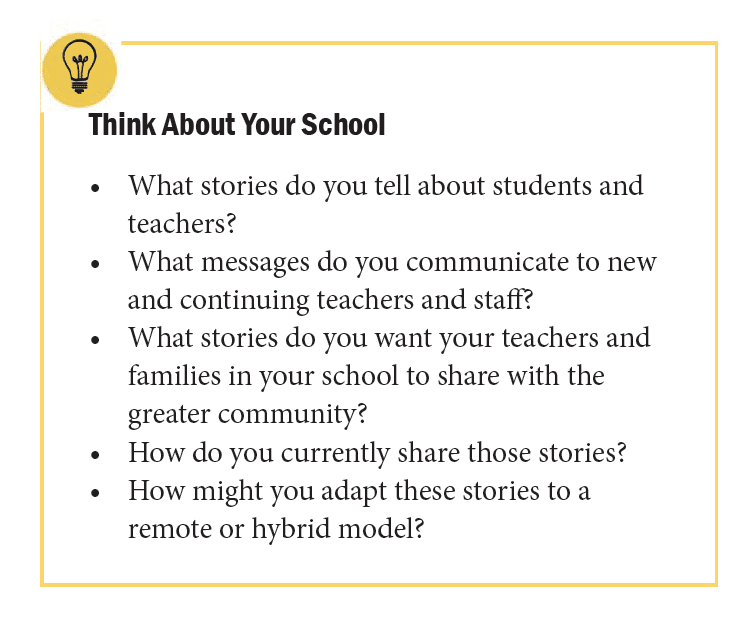
An elementary principal in Washington state has begun planning for the beginning of the next school year. As he’s remotely interviewing candidates for positions he’s asking each person offered a position to make a video that could be shared with new and returning faculty as well as with the families of their students. He asked them to personalize the video but to focus on the sort of things they would say to introduce themselves on opening day. At the same time, the principal is asking his veteran teachers to do something similar.
In Michigan one middle school principal has accelerated her use of the school’s social media sites. The sites have been primarily used to post announcements and share other information. But with the assistance of the school’s technology teacher, and two students, the principal has begun more frequent sharing of stories about the school, it’s students and staff, and their successes.
In western Michigan an elementary principal decided to engage more with local online media. That included Patch.com and NextDoor (nextdoor.com). Both are sites that are focused on regional or neighborhood news. She uses the sites to share short videos or other presentations about the local elementary school. She also says that following both sites serves as an “early warning system” for issues that may be emerging in the local school community.
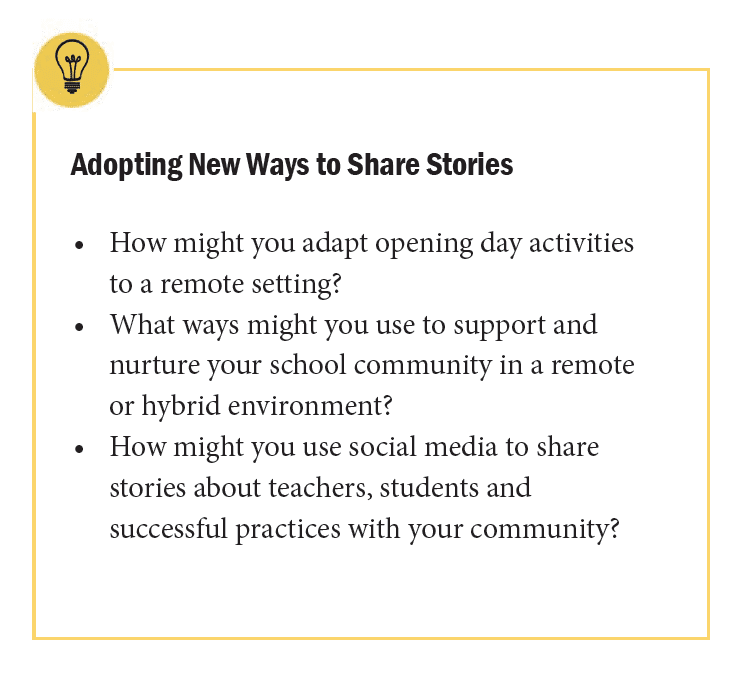
Ceremonies and Rituals
Another way culture is evident is in the routines of school life, the rituals that occur regularly. Similarly, schools have special events and activities throughout the year and those events, the ceremonies, also are a manifestation of culture.
Daily routines are not often thought of as a reflection of culture but each one, from morning greetings, attendance or lunch procedures, to how the end of the day is managed reflects values about students, student behavior and school safety.
Ceremonies are those special events that occur during the year. The choice of events and the way they are celebrated signals the school’s priorities and values.
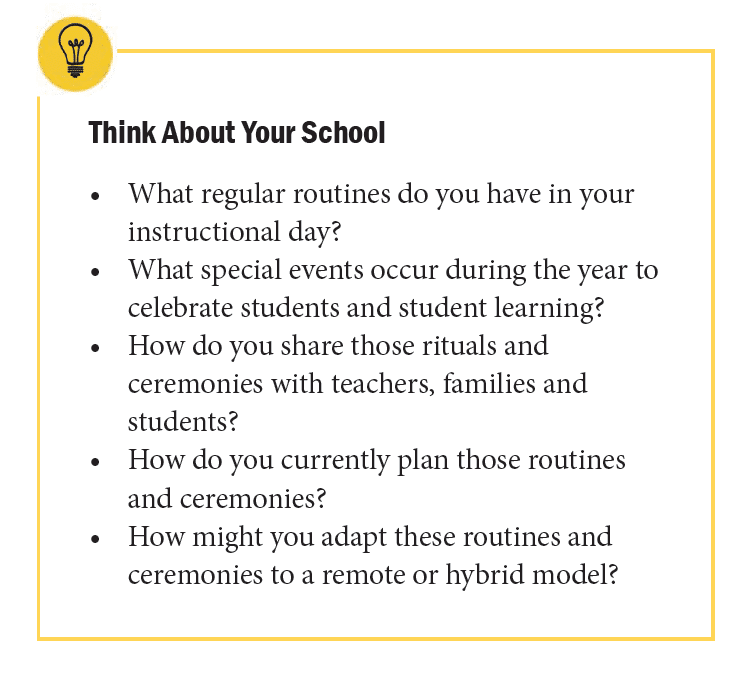
In Central Oregon an elementary principal talked with Ron about how much she misses the morning routine of greeting students and staff as they arrive, meeting the buses, and visiting classrooms to greet students. She said, “The suddenness of moving to remote learning sort of stunned us. Things we used to do routinely, weren’t done anymore.” But she went on to say that after a few weeks she recognized how important those routines were to everyone, including herself. So, she began to send a short morning greeting to students and staff, sometimes via video, sometimes not. But she always made it upbeat, supportive and encouraging. She kept it short and always thanked people and expressed her appreciation. She also decided to make online visits to classrooms during Zoom lessons. Often, she sat quietly and observed. Occasionally she said a few words. “It was important to everyone including the students to know I’m still here.”
At an elementary school in Bothell, WA the grade-level teams decided there needed to be a thoughtful plan for their online instruction. So, they adapted the curriculum to fit a new model, one that recognized the constraints some families had accessing technology or due to parent work schedules. Monday and Wednesday were devoted to reading and language arts, Tuesday and Thursday to math and science. Friday was set aside as “social-emotional learning” day and they worked with their students on team building activities including the “Friday themes” they would have had face-to-face. An occasional Friday was pajama day, another stuffed animal day, and yet another school colors day. One teacher said, “It added some order to the week for everyone including the teachers. It was just another way of doing what we had done before.”
Another example comes from a middle school principal in southeastern Michigan. He described how he missed teachers dropping by the office to talk about issues or even just to chat. So, he began Zoom office hours. He set a time when he would be available online and invited teachers to either schedule an appointment or just drop by and talk. He was surprised at how many of his teachers dropped by, often just to talk and seek advice. It turned out, he said, “to be one of the most helpful things I did. It was a bit of normal in a very abnormal time.”
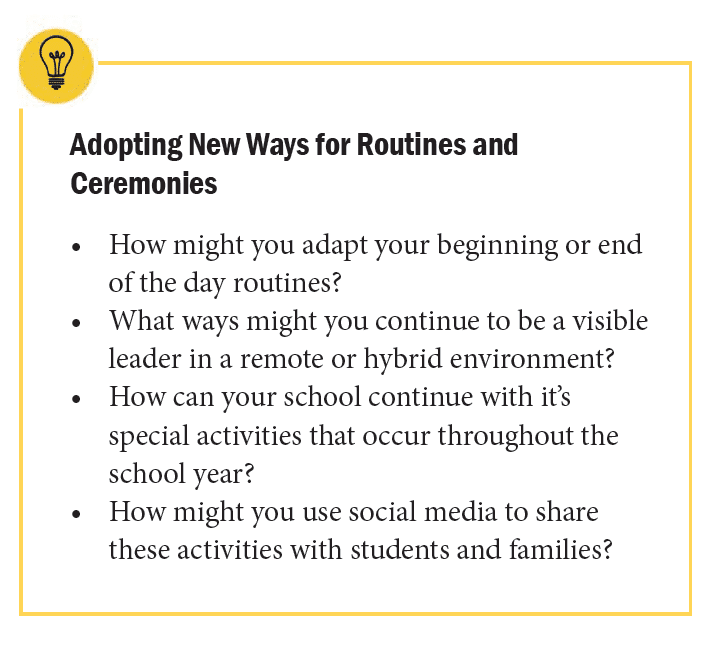
Recognizing Heroes and Heroines
A third way culture is reflected in a school is through the people who are recognized, the heroes and heroines of your school. We often think of formal honors and awards. But it is the subtle, less visible, ways people are honored that can be important. As with the personal stories you tell, the personalization of recognition is essential for students and staff.
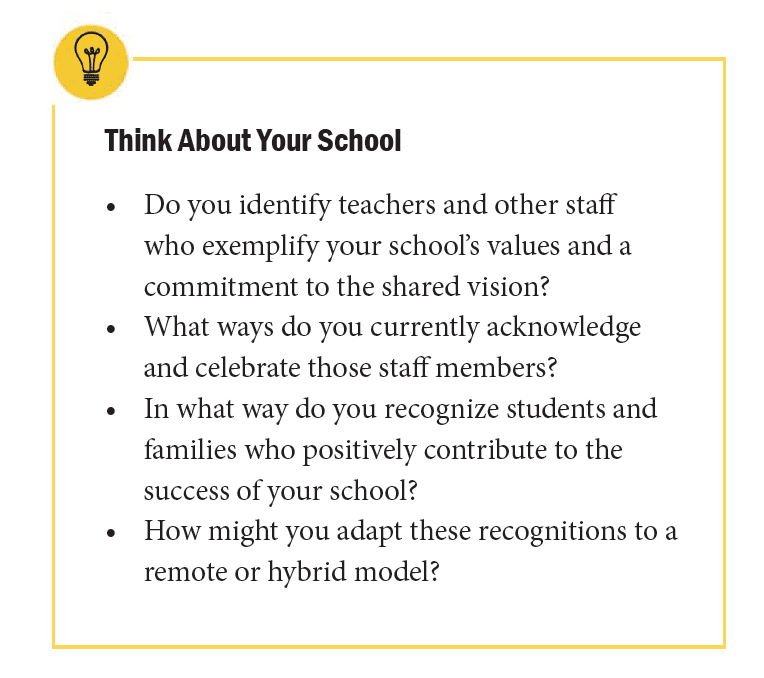
We’ve been talking with teachers and principals around the country about their experience with remote learning. Almost always they talked about the need for support for their work and acknowledgement of everything they’ve done.
A middle school principal in one of Ron’s classes talked about “checking-in” with every teacher. “Each week I make sure I include a personal check-in with everyone. It’s personal. It’s not part of a large Zoom staff meeting. And it’s a time I can express my support and ask “What can I do to support your work?”
Support can take many forms and sometimes the most modest recognition can be the most meaningful. One way to celebrate quality instruction is to use “Name It, Claim It, and Explain It.” As you see an example of quality instruction in a classroom, take a digital picture or video of what occurs. Then, begin each of your faculty meetings by projecting the picture or video. Explain to your faculty, “I saw something great related to rigor this week. It’s up here on the screen. If it belongs to you, stand up and name what you did, claim it as yours, and explain what you were doing.”
This is equally effective in a virtual setting. Take a screen shot or edit a portion of a video. Share via email or post on a variety of available platforms. After the appropriate teacher claims and explains it, other teachers can respond.
Most teachers and principals are grappling with the change to remote learning. By being patient, compassionate, and sensitive with teachers, leaders can model the ways we want them to interact with students and families.
One elementary principal in North Carolina talked with Ron about the importance of finding resources for teachers. “They need both instructional support as well as technical support. My job is to make that available.” She described how she designed a weekly professional development newsletter with links to online resources, stories about the work of other teachers across the country, and different ideas for supporting students and families.
At one middle school in southern Michigan the principal described how her teachers began to accumulate examples of funny things that occurred online. They included everything from student snacks while online, to the things students wanted to show the rest of the class. One student used his tablet to conduct an online tour of his home but forgot to clear it with the rest of their family. The examples also included funny things teachers had done. One teacher actually conducted class from her walk-in closet, the only place she could get away from other family members who were also online or working from home.
So, every week the principal collected the examples and the staff voted on the “example of the week.” Much like the TV show, America’s Funniest Home Videos, this award served as a way to have a little fun and acknowledge the trials and tribulations of the move to remote learning.
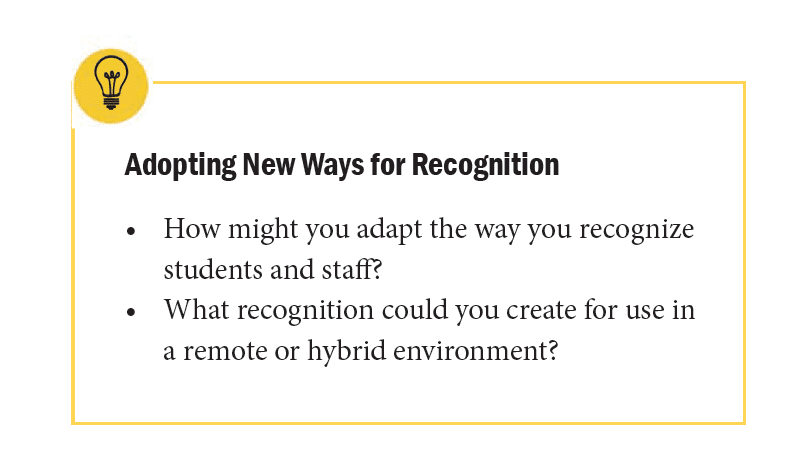
Final Thoughts
While the future is unclear, what is certain is that remote learning may become a regular part of American education. While the move to remote learning was swift, it provides an opportunity to learn from the experience, to adopt some new practices and adapt others. What’s essential is the need to nurture and sustain the school community present in every school.
Dr. Ronald Williamson is a professor of leadership and counseling at Eastern Michigan University. He was a middle grades teacher, principal, and executive director of instruction in Ann Arbor, MI. He works with middle grade schools across the country and is the author of numerous books, including “7 Strategies for Improving Your School” (Routledge, 2019). He can be reached through his website. Visit ronwilliamson.com.
Dr. Barbara Blackburn was recently named one of the Top 30 Global Gurus in Education. She is a best-selling author of more than 20 books including “Advocacy from A to Z” written with Robert Blackburn (her dad) and Ron Williamson. An internationally recognized expert in the areas of rigor and motivation, she collaborates with schools and districts for professional development.
References
Peterson, K. D. & Deal, T. E. (2002). The Shaping School Culture Fieldbook. San Francisco, CA: Jossey-Bass.
Williamson, R. & Blackburn, B. (2020). 7 Strategies for Improving Your School. New York: Routledge.
TEPSA Leader, Summer 2020, Vol 33, No. 3
Copyright © 2020 by the Texas Elementary Principals and Supervisors Association. No part of articles in TEPSA publications or on the website may be reproduced in any medium without the permission of the Texas Elementary Principals and Supervisors Association.


